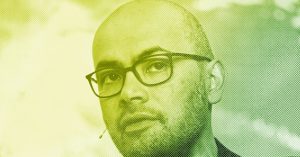In a press release published last week, Washington DC-based Gallaudet University’s, the preeminent collegiate institution for Deaf and hard-of-hearing people, announced a groundbreaking collaboration with telecom company AT&T to provide what the school called “the first 5G-connected football helmet.” The technology, conceptually akin to the radios which let coaches communicate play calls to the quarterback, was built with the intention of “making the game more inclusive by enhancing on-field communication for student-athletes who use American Sign Language.”
Gallaudet’s Bisons football team, who play in NCAA Division III, debuted use of the technology in a game over the weekend against Hilbert College. Gallaudet won 34–20, improving to 1–4 this season.
“From inventing the modern-day huddle in 1894 to serving as the global leader in education for deaf and hard-of-hearing students today, Gallaudet University has long been a pioneer for innovation. Deaf and hard of hearing athletes have a long history of breaking barriers and proving their innovation and talent on the field,” Gallaudet wrote in its press release. “The helmet will allow coaches on the sideline to select a play from a tablet that will send the play to a lens inside the helmet. The quarterback wearing the helmet will receive the play in augmented reality (AR) on the digital display located within the visor. AT&T 5G provides the reliability and low latency for plays to be sent and received at a speed that keeps up with the pace of the game. By displaying the coach’s play through augmented reality, this technology eliminates a gap for deaf and hard of hearing athletes, making football more inclusive. It can also reduce miscommunication and unwarranted penalties.”
AT&T has posted a short video on the new helmets to YouTube.
In an interview with me last week conducted over email, Gallaudet head coach Chuck Goldstein explained the advent of the new helmets will “help us bridge the gap to leveling the playing field” for his team, saying the helmets look exactly like a standard one except they have the display inside and are custom-fitted to each player. Goldstein added the tech-infused helmets help enable clear communication, which in turn removes any margins for error. On the field, this is a breakthrough development because, Goldstein said, the coaches have to cope with bad play calls due to the inability to “get the attention of our quarterback.”
“This [the connected helmets] will have a huge impact for any deaf and hard-of-hearing player in the country, especially those who play on mainstream football teams,” Goldstein said of the helmets’ significance.
For AT&T, Gallaudet noted in its press release the company believes the new helmet technology can have lasting ramifications on inclusivity in sports and player safety. Corey Anthony, AT&T’s senior vice president of network engineering and operations, said in part in a statement the helmets “not only transforms the way deaf and hard-of-hearing athletes engage in sports but opened up endless possibility for innovation.”
For Andrew Bennett, he feels similarly to his colleague’s sentiments. In an interview with me concurrent to Goldstein’s, Bennett, who serves as AT&T’s assistant vice president of mass-market 5G products, told me AT&T has a storied history of “developing innovative technology that implements more inclusive communication.” He added the company desired to “evolve communications” for the Deaf community, saying technology has advanced sufficiently enough to make the connected helmet possible. The deep and continuous collaboration with Gallaudet on this project, Bennett said, “was instrumental in turning this idea into reality.” The feedback from coaches and players was key, according to Bennett. “The deep collaboration with them throughout the development process was crucial in ensuring proper inclusive design,” he said.
“By introducing Real Time Text, there was significant improvement in accessible telecommunications, and by working with the community to get their input, AT&T was able to address their needs and push updated FCC rules that would allow for the transition to RTT,” Bennett said.
Both Goldstein and Bennett expressed optimism about the future potential of this newfound helmet technology. At a technical level, Bennett said AT&T would “love” to see technology like that found in the helmets be adopted across mainstream sports, adding the company is investigating ways to spur along adoption. Goldstein said the entire team “embraced this opportunity” to pioneer the helmets, adding everyone was excited to be part of such a seminal moment in football history.
“We will all remember this for years to come,” Goldstein said.
For more on Gallaudet University and its mission to serve the Deaf and hard-of-hearing community, check out this profile I did last December on president Roberta Cordano. She has sat on the top perch since 2016.
Read the full article here










